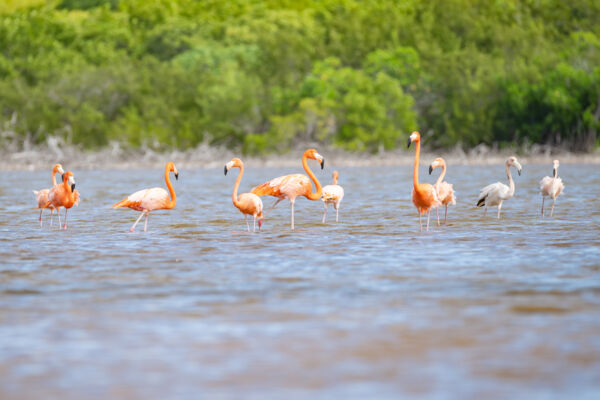Providenciales, Turks and Caicos Islands — New research suggests that more than 5,300 American flamingos (Phoenicopterus ruber) inhabit the Turks and Caicos Islands. This accounts for approximately 2.5% of the species’ global population.
These findings published in a study in the Journal of Caribbean Ornithology last month represent the first comprehensive population estimate carried out for Phoenicopterus ruber in the Turks and Caicos.
While American flamingos are commonly associated with the salt salinas found in several of the archipelago’s settlements, most flamingos the surveyors observed were actually in natural lakes that experience little to no human disturbance. Flamingo Pond on North Caicos was found to be the most important dwelling site for American flamingos in Turks and Caicos, supporting over 50% of the country’s Phoenicopterus ruber population in surveys.
“We now have a better idea of where the flamingos are and which habitats they use,” says Simon Busuttil, lead author of the study and the Turks and Caicos Biosecurity Project Manager for the Royal Society for the Protection of Birds (RSPB), a UK-based conservation society. “[Our findings] emphasize the need to protect these lakes from disturbance, or perhaps to do a little more work on the salinas to make them even more attractive to flamingos.”
Researchers also provided the first comprehensive American flamingo data for the remote and uninhabited island of East Caicos, counting 1,116 individuals (22% of the local flamingo population). The highest previous record of Phoenicopterus ruber sightings on the island was 250.
Country-wide flamingo population data was collected via multiple aerial surveys performed in February 2024 and May 2024. Researchers used a low-flying aircraft to survey 49 known flamingo flock sites across the country, covering all of the main islands and numerous small cays. Flamingo flocks were extensively photographed from various angles and later counted on enlarged images.
Interestingly, researchers did not find any evidence of flamingos breeding in the islands. This suggests that the Turks and Caicos Islands’ American flamingo population may be breeding in Inagua National Park in the Bahamas, approximately 81 miles (130 km) southwest of Providenciales. Inagua is home to around 70,000 flamingos and is the largest American flamingo colony in the Caribbean.
The new population estimate for Turks and Caicos will act as a baseline from which future research can be done.
“[This research] is not just a matter for the Turks and Caicos Islands,” says Busuttil. “If we understand what’s happening with the flamingos in each country, we can understand what’s happening to the whole population globally, and either take action to conserve them or not.”
Currently, the species' global population appears to be increasing, according to the IUCN Red List, which lists Phoenicopterus ruber's conservation status as a species of least concern. Efforts taken in the Bahamas over the years to conserve critical breeding habitat is likely what has saved the American flamingo population—which during the mid-1900s only numbered in the few thousands globally, says Busuttil—from extinction.
The American flamingo, also known as the Caribbean flamingo or West Indian flamingo, is found throughout the Turks and Caicos Islands. The species is featured on the country’s coat of arms and has inspired numerous place names throughout the archipelago—at least five islands in the Turks and Caicos have a wetland or pond named after flamingos.
Other research done in recent years has shown that Turks and Caicos Islands is a globally important habitat for several other species of bird, including reddish egrets.
About Visit Turks and Caicos Islands
Visit Turks and Caicos Islands (VisitTCI.com) is the largest media and information website in the Turks and Caicos and the leading source of authoritative information for residents and visitors of the country. With over 1,000 pages of original content and 6,000 professional photographs, VisitTCI.com is the trusted brand for the more than 2 million unique users it serves per year.



